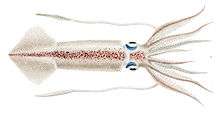Doryteuthis gahi
Doryteuthis gahi, also known as the Patagonian squid and locally as calamar,[2] is a small-sized squid belonging to the family Loliginidae. It occurs in coastal waters in the southeastern Pacific Ocean and the southwestern Atlantic Ocean where it is caught and eaten for food.
| Patagonian squid | |
|---|---|
 | |
| Scientific classification | |
| Kingdom: | Animalia |
| Phylum: | Mollusca |
| Class: | Cephalopoda |
| Order: | Myopsida |
| Family: | Loliginidae |
| Genus: | Doryteuthis |
| Species: | D. gahi |
| Binomial name | |
| Doryteuthis gahi | |
| Synonyms[1] | |
| |
Description
The Patagonian squid is a small species and has a mantle length of 10 to 15 cm (4 to 6 in) and a weight of between 75 and 150 grams (2.6 and 5.3 oz).[3] The mantle is somewhat elongated and on either side at the posterior end are rhomboidal fins, rather less than half the length of the mantle. At the anterior end are four pairs of arms and a pair of tentacles. The third and fourth pairs of arms are longer than the others, and in males, the left fourth arm is heterodactylised near its tip. The tentacles are long and slender, each terminated by a club-shaped "manus" with small, narrow suckers at the edge and slightly larger ones at the centre.[2]
Distribution
This squid occurs in the southeastern Pacific Ocean and the southwestern Atlantic Ocean. In the Pacific its range extends along the coast from southern Peru to southern Chile, and in the Atlantic, from the San Matías Gulf in Argentina southwards to Tierra del Fuego, including the continental shelf around the Falkland Islands. It is an open-water species with a depth range from the surface down to about 350 m (1,150 ft).[2]
Biology
Little is known of the biology of this species, but like all squid, it is a predator. Prey items are caught by the tentacles, grasped and moved to the mouth with the help of the arms, and then chewed by the horny beak.[4] In Chile, spawning grounds have been identified at depths of between 10 and 15 m (33 and 49 ft). Fragile egg masses some 25 mm (1 in) long containing about 15 embryos have been found among stems of the kelp Lessonia trabeculata, particularly in places where the algae has been heavily defoliated, suggesting that a semi-protected environment with adequate water movement is desirable.[5]
Uses
In the Pacific Ocean and off Argentina, this species is mostly caught as bycatch during trawls directed at other species. There is a dedicated fishery in the Falkland Islands where it is an important target species taken from over the Patagonian Shelf. The total reported world catch in 1999 was 42,505 t (41,834 long tons; 46,854 short tons), with the largest catch being from the Falkland Islands (22,502 t (22,147 long tons; 24,804 short tons)).[2][6]
References
| Wikimedia Commons has media related to Doryteuthis gahi. |
- Finn, Julian (2018). "Doryteuthis (Amerigo) gahi (d'Orbigny, 1835)". WoRMS. World Register of Marine Species. Retrieved 11 November 2018.
- "Species Fact Sheet: Loligo gahi (Orbigny, 1835)". FAO. Retrieved 11 November 2018.
- "Fisheries Department Fisheries Statistics, Volume 14, 2009:" (PDF). Falkland Islands Government. 2010. Retrieved 11 November 2018.
- Ruppert, Edward E.; Fox, Richard, S.; Barnes, Robert D. (2004). Invertebrate Zoology, 7th edition. Cengage Learning. pp. 355–356. ISBN 978-81-315-0104-7.
- Inshore Spawning Grounds of the Squid Doryteuthis Gahi Suggest the Consistent Use of Defoliated Kelp Lessonia Trabeculata in Central Chilean Waters. Taylor & Francis. 2016.
- "Fishery Statistics Volume 11 (1997–2006)" (PDF). Falkland Islands Government. 2007. pp. iv, viii. Retrieved 4 May 2015.